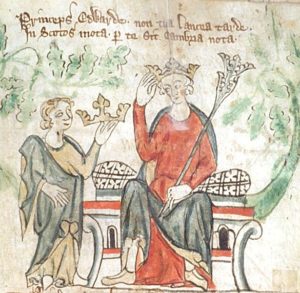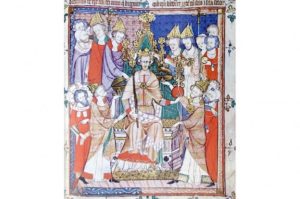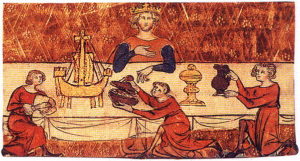 Edward II also called Edward of Caernarfon, was the fourth son of Edward I and his first wife, Eleanor of Castile. When King Edward I died on 7 July 1307 at Burgh by Sands, Prince Edward on receiving the news immediately travelled from London and on 20 July he was proclaimed king. He continued north into Scotland and on 4 August received homage from his Scottish supporters at Dumfries, before abandoning the campaign and returning south. Edward promptly recalled Piers Gaveston, who was then in exile, and appointed him as the Earl of Cornwall, before arranging his marriage to the wealthy Margaret de Clare. Edward also arrested his old adversary Bishop Langton, and dismissed him from his post as treasurer. Edward I’s body was kept at Waltham Abbey for several months before being taken for burial to Westminster, where Edward erected a simple marble tomb for his father.
Edward II also called Edward of Caernarfon, was the fourth son of Edward I and his first wife, Eleanor of Castile. When King Edward I died on 7 July 1307 at Burgh by Sands, Prince Edward on receiving the news immediately travelled from London and on 20 July he was proclaimed king. He continued north into Scotland and on 4 August received homage from his Scottish supporters at Dumfries, before abandoning the campaign and returning south. Edward promptly recalled Piers Gaveston, who was then in exile, and appointed him as the Earl of Cornwall, before arranging his marriage to the wealthy Margaret de Clare. Edward also arrested his old adversary Bishop Langton, and dismissed him from his post as treasurer. Edward I’s body was kept at Waltham Abbey for several months before being taken for burial to Westminster, where Edward erected a simple marble tomb for his father.
Edward married 12 year old Isabella of France (She-Wolf of France) at Boulogne-sur-Mer on 25 January 1308. The pair returned to England in February, where Edward had ordered Westminster Palace to be lavishly restored in readiness for their coronation and wedding feast, complete with marble tables, forty ovens and a fountain that produced wine and pimento, a spiced medieval drink. After some delays, the ceremony went ahead on 25 February, officiated by Henry Woodlock, Bishop of Winchester as Robert Winchelsey, archbishop of Canterbury, was ill and out of the country.
The coronation differed from its predecessors in several aspects. Firstly, the wives of peers attended for the first time. Secondly, Edward took his oath in French, not Latin and thirdly, a new clause was added to the coronation oath: “Sire, do you grant to be held and observed the just laws and customs that the community of your realm shall determine, and will you, so far as in you lies, defend and strengthen them to the honour of God?”
 Edward and Isabella stayed at the Tower of London from 19 to 24 February. They left buy riding through London in procession to Westminster. On the morning of the 25th, they walked from Westminster Hall to the Abbey, along a carpet strewn with flowers. Edward wore a green robe and black hose, and was barefoot. Above them, the barons of the Cinque Ports carried an embroidered canopy, and before them, proceeded the prelates and the barons. Directly preceding Edward and Isabella were, in this order: William Marshal, carrying the gilt spurs; Edward’s brother-in-law the earl of Hereford carrying the royal sceptre; his cousin Henry of Lancaster carrying the royal rod; the earls of Lancaster, Warwick and Lincoln carrying the three swords. Then, four men carrying a board covered with chequered cloth, on which the royal robes were placed. They were Hugh Despenser the elder, Roger Mortimer, Thomas de Vere, son of the earl of Oxford, and Edmund Fitzalan, earl of Arundel. Mortimer, de Vere and Arundel were cousins. Then, Edward’s treasurer Walter Reynolds, carrying the paten of the chalice of St Edward the Confessor, and the chancellor John Langton carrying the chalice itself. And finally, and controversially, Piers Gaveston, just before the king and queen and therefore in prime position, carrying the royal crown. Gaveston wore pearl-encrusted silk robes of imperial purple—a colour reserved for royalty—whilst the other earls wore the traditional cloth of gold. Gaveston also organised the banquet.
Edward and Isabella stayed at the Tower of London from 19 to 24 February. They left buy riding through London in procession to Westminster. On the morning of the 25th, they walked from Westminster Hall to the Abbey, along a carpet strewn with flowers. Edward wore a green robe and black hose, and was barefoot. Above them, the barons of the Cinque Ports carried an embroidered canopy, and before them, proceeded the prelates and the barons. Directly preceding Edward and Isabella were, in this order: William Marshal, carrying the gilt spurs; Edward’s brother-in-law the earl of Hereford carrying the royal sceptre; his cousin Henry of Lancaster carrying the royal rod; the earls of Lancaster, Warwick and Lincoln carrying the three swords. Then, four men carrying a board covered with chequered cloth, on which the royal robes were placed. They were Hugh Despenser the elder, Roger Mortimer, Thomas de Vere, son of the earl of Oxford, and Edmund Fitzalan, earl of Arundel. Mortimer, de Vere and Arundel were cousins. Then, Edward’s treasurer Walter Reynolds, carrying the paten of the chalice of St Edward the Confessor, and the chancellor John Langton carrying the chalice itself. And finally, and controversially, Piers Gaveston, just before the king and queen and therefore in prime position, carrying the royal crown. Gaveston wore pearl-encrusted silk robes of imperial purple—a colour reserved for royalty—whilst the other earls wore the traditional cloth of gold. Gaveston also organised the banquet.
Isabella’s uncles Charles of Valois and Louis of Evreux attended the coronation, as did her brother Charles, the future Charles IV, and Edward’s sister Margaret and brother-in-law Jan, the duke and duchess of Brabant. Presumably, his other sisters Elizabeth, countess of Hereford, and Mary, the nun, also attended, as did the mayor, aldermen and citizens of London.
At the altar, Edward and Isabella both made offerings of gold. During the ceremony, the count of Valois put on Edward’s left buskin (a kind of boot) and left spur, the earl of Pembroke Edward’s right buskin, and Gaveston the right spur – to the anger of many, as these duties were of profound significance, and Edward was publicly placing Gaveston above the rest of the nobility. This caused outrage among the earls and nobles.
Edward swore his oath and was anointed with holy oil on head, hands and chest, then he himself raised his crown from the altar and handed it to Bishop Woodlock, who placed it on Edward’s head. Edward was then escorted to his gilded and painted throne, with the Stone of Scone underneath, which his father had removed from Scotland eleven years earlier. A long line of prelates and barons came to kneel before him and swear (homage and) fealty. Finally, it was Isabella’s turn to be consecrated, crowned and anointed, on the hands only.
The oath went as follows:
Sire, will you grant and keep and by your oath confirm to the people of England the laws and customs given to them by the previous just and god-fearing kings, your ancestors, and especially the laws, customs, and liberties granted to the clergy and people by the glorious king, the sainted Edward, your predecessor?
I grant and promise them.
Sire, will you in all your judgments, so far as in you lies, preserve to God and Holy Church, and to the people and clergy, entire peace and concord before God ?”
I will preserve them.
Sire, will you, so far as in you lies, cause justice to be rendered rightly, impartially, and wisely, in compassion and in truth?
I will do so.
Sire, do you grant to be held and observed the just laws and customs that the community of your realm shall determine, and will you, so far as in you lies, defend and strengthen them to the honour of God?
I grant and promise them.
 Edward and Isabella received the sacrament, and then were escorted back to the palace, Edward carrying the royal verge (his staff of office) in his left hand. Piers Gaveston carried the sword Curtana, which the earl of Lancaster had carried previously in the procession to the Abbey, which caused more mutterings, or rather shouts, of discontent. Edward changed out of his coronation robes and proceeded with all the others to Westminster Hall, where a banquet was to take place. Edward knighted several young men at this time, including his sixteen-year-old nephew the earl of Gloucester.
Edward and Isabella received the sacrament, and then were escorted back to the palace, Edward carrying the royal verge (his staff of office) in his left hand. Piers Gaveston carried the sword Curtana, which the earl of Lancaster had carried previously in the procession to the Abbey, which caused more mutterings, or rather shouts, of discontent. Edward changed out of his coronation robes and proceeded with all the others to Westminster Hall, where a banquet was to take place. Edward knighted several young men at this time, including his sixteen-year-old nephew the earl of Gloucester.
Edward had ordered tapestries bearing his own arms, and those of Piers Gaveston, to adorn the walls of the hall, as though Gaveston was his consort and not Isabella. He then made matters worse by sitting next to Gaveston and ignoring everyone else, including Isabella, talking and laughing with his friend. Isabella’s uncles were offended. Edward’s behaviour was extremely insulting to the French.
After the banquet, the counts of Evreux and Valois returned to France and complained to Isabella’s father Philip IV that Edward II favoured Gaveston’s couch to Isabella’s bed.
The event was marred by the large crowds of eager spectators who surged into the palace, a knight called John Bakewell was crushed to death in the great crowd of people in the Abbey. A wall was knocked down and Edward was forced to flee by the back door. Overall, the coronation was a major fiasco as the nobility deplored Piers Gaveston’s organisational skills. It affected the Anglo-French alliance at the time.
